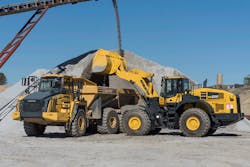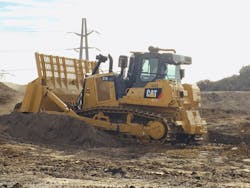Rebuilding that piece of equipment could garner several thousand more hours of useful life.
A bare-frame rebuild removes every component system from the machine down to its skeleton, assesses each part’s condition, replaces worn systems with brand new parts, adjusts settings, updates supporting technology, and gives the unit a shiny new coat of paint. After the rebuild, the OEM’s dealer can offer additional warranty protection similar to a new machine warranty.
John Meese, CEM, is senior director of heavy equipment for Waste Management, and its rebuild program has performed more than 600 bare-frame rebuilds since 2012.
“From an economic standpoint, performing a full machine rebuild on an asset makes all the sense in the world,” Meese says. “Experience tells us that we can perform that style rebuild at 50 to 60 percent of the cost of purchasing a new machine.
“The first thing to know when you’re weighing the economic pros and cons of rebuilding is to use the same evaluation method for all of your fleet’s individual vehicles,” Meese says. “Inserting emotions or wishful thinking when considering the rebuild question will almost always end up costing you money and add to your stress levels.”
Below is a time-lapse video of a wheel loader rebuild provided by Volvo Construction Equipment.
Be honest with expectations, Meese suggests: Will rebuilding the machine restore its original capabilities and serve future applications?
Other questions to consider: Has the unit reached its desired number of hours with only minor repairs? Is it still under warranty? Do service records show its fluid samples are clean and stable? Are the operator safety and comfort systems still functioning well? Can adding new technology to the rebuild package allow that older machine to meet modern expectations?
Determining the timing for a rebuild is a multifaceted consideration, which should include the costs of renting temporary equipment.
“Most fleet managers subscribe to the theory that there is a ‘right time’ to either rebuild or trade-in a machine,” says Dan Stecklein, product manager/service marketing for John Deere. “Looking at it from the perspective of ownership costs, the longer you keep a machine in service the better, because by doing so, it divides that initial purchase price by a greater number of hours and lowers the operating cost per hour.”
Stecklein notes that as the machine’s maintenance and repair costs increase over time, at some point the rate of increase in repair costs exceeds the rate of decrease in ownership costs.
“That is the point at which most fleet managers will make the decision to either trade it or rebuild it,” he says. “This point typically occurs between 10,000 and 20,000 hours, depending on the machine type and the conditions in which it is operating.”
Komatsu defines the right time for rebuilding by analyzing actual wear on the machine’s original components and comparing those observations with data gleaned from engineering risk analysis.
“Regardless of when the overhaul is performed...the timing of a rebuild is very important,” says Goran Zeravica, senior product manager for reman and overhaul.
Komatsu uses a statistical product reliability presumption that relates to the probability of when a component will fail as determined by observations of other components just like it used in the same conditions. Komatsu engineers note at what hours parts have been observed to lose functionality assuming variables such as maintenance history, operator performance, and application severity are reasonably equal. Naming these positions B5 Life, B10 Life, B15 Life, and so on allows Komatsu to reliably predict when a component will begin to lose its functionality.
“We find the best time to rebuild is slightly after B5 component life,” says Zeravica. “At that point, the customer can get the highest dollar-value for the components removed from the current machine. If, however, a customer chooses to run beyond a component’s life—B10, B15, or B20 life—the risk that he or she runs is that the core may be damaged or even fail and will therefore have limited or no value.”
David Bolderoff, CEM, fleet manager at the Sanitation Districts of Los Angeles County in Whittier, California, uses a lot of Cat D9 dozers. When used Tier 4 D9s were is short supply, he acquired some Tier 3 D9s, then had Caterpillar rebuild them, updating the dozers and extending the warranty.
“We bought them at 25 percent of what a used machine would cost,” says Bolderoff. “It was a good interim move for us. We saved about 30 percent over the cost of ownership in the past four years.” Bolderoff says he does up to three rebuilds on a machine.
Rebuilding isn’t much of a bargain for smaller machines. Bolderoff says the more expensive the equipment is, the more it makes sense to rebuild it. He says in the case of mining equipment, which he has managed in the past, adding three more lives to the machine is commonplace. The same goes for specialized equipment and machines that have been adapted by a dealer for specific applications.
At some point, though, Bolderoff says an older machine’s technology and production features won’t compare to newer units no matter what updates are added.
Warranties applied to rebuilt equipment vary by manufacturer.
“Cat’s program has three tiers: a single component can be rebuilt as many times as you want, as can the powertrain,” says David Matranga, aftermarket repair options manager for Caterpillar. “A full machine rebuild can only be done one time with warranty coverage due to the frame life.
“Cat designs our components to live multiple lives,” he says. “Depending on where you are in the world, much of the cost of rebuilding is in labor, so doing a smaller vehicle like a skid steer isn’t advised.” Popular machines to rebuild are Caterpillar D6 dozers, off-highway trucks, 980 wheel loaders, and motor graders, he says.
Where the rebuild occurs matters in several ways. Deere says using a certified rebuild center, usually at a dealership, can help the owner decide how the machine should be rebuilt.
“For example, if a customer has a 17,000-hour machine and needs it to go another 5,000 hours, the dealer would provide a recommendation on the work needed to get them to that hour level, and the associated cost,” Stecklein says. “If the customer now decided that instead of another 5,000 hours, they needed it to go another 14,000 hours, the dealer would give them a different set of rebuild recommendations, which would likely require a different investment. If the customer was planning to put that machine into a less-demanding application after the rebuild, it may last longer under those conditions than it did when it was originally in the tougher application.”
Komatsu’s Zeravica says the value of having an OEM dealer do the rebuilds, rather than a third party, is in the technology and support.
“While an aftermarket choice may appear the ‘cheapest’ on the surface, what differentiates whether an owner chooses to go with an OEM and its distributors—as compared to not doing a rebuild and/or doing a rebuild at an aftermarket establishment—are the programs and support packages OEMs can offer.”
With the additional hours of work a rebuild affords a machine, plus the warranty coverage if applicable, an equipment manager will not only conserve capital investment funds but also keep owning and operating costs at a lower, more manageable level.






